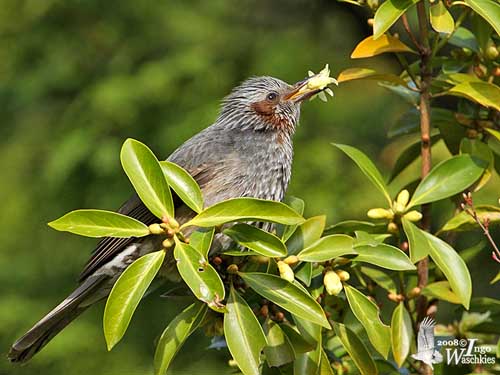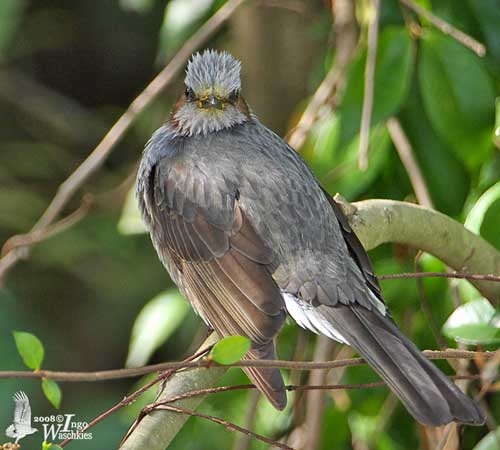
Fr: Bulbul à oreillons bruns
All : Orpheusbülbül
Esp: Bulbul de Orejas Castañas
Ital: Bulbul orecchiecastane
Nd: Bruinoorbuulbuul
Sd: Japansk bulbyl
Photographer:
Ingo Waschkies
Bird Photography
Text by Nicole Bouglouan
Sources:
HANDBOOK OF THE BIRDS OF THE WORLD Vol 10 by Josep del Hoyo-Andrew Elliott-David Christie - Lynx Edicions - ISBN: 8487334725
L’ENCYCLOPEDIE MONDIALE DES OISEAUX - Dr Christopher M. Perrins - BORDAS - ISBN: 2040185607
BirdLife International (BirdLife International)
CREAGUS@Monterey Bay (Don Roberson)
Wikipedia, the free encyclopaedia
Brown-eared Bulbul
Microscelis amaurotis
Passeriforme Order – Pycnonotidae Family
INTRODUCTION:
The Brown-eared Bulbul is now isolated in the monotypic genus Microscelis, after numerous analysis and research. It was formerly in the genus Hypsipetes. This species is one of the most abundant and common in Japan, and occurs in varied habitat types, including gardens and city centres.
This bird is known for uttering unattractive noise, a loud and unbecoming call. Its Japanese name is “Hiyodori”.

DESCRIPTION OF THIS BIRD:
Biometrics:
Length: 28 cm
Weight: 30-35 g
The adult of nominate race has dark ashy-grey upperparts. Wings and tail are slightly browner.
On the underparts, throat and breast are ashy-grey, whereas lower breast and centre of belly show larger white spots. Flanks and thighs are grey-brown. Undertail-coverts are dark grey with broad white edges.
On the head, crown and nape are ashy-grey with greyish-white tips. Ear-coverts and neck sides are chestnut-brown. The elongated, pointed crown feathers form a slight crest.
The bill is black. The eyes are reddish-brown. Legs and feet are dark reddish.
Both sexes are similar.
The juvenile is browner than adult, and lacks the pale grey wash.
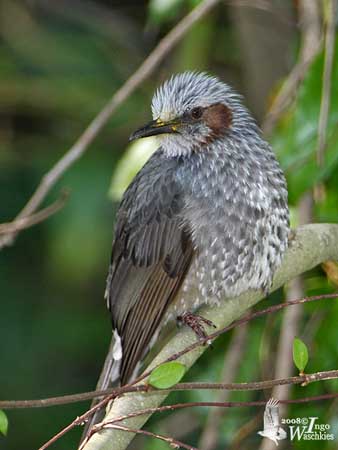
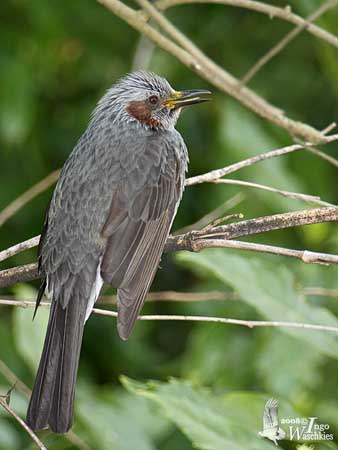
SUBSPECIES AND RANGE:
There are 11 subspecies which differ in size, tones and plumage pattern. The nominate race is here described and displayed.
This species occurs from Russian Far East, through NE China, the Korean Peninsula, Japan, S to Taiwan, Babuyan and Batanes Island chains in N Philippines, and it may occur occasionally in Luzon too.
HABITAT:
The Brown-eared Bulbul frequents deciduous, mixed and evergreen forests, from lowlands and foothills to 1600-2100 metres of elevation during the breeding season.
During winter, it is mostly seen in open cultivated areas with groves and hedgerows. It is commonly found in suburban parks and gardens, and urban areas including city centres.
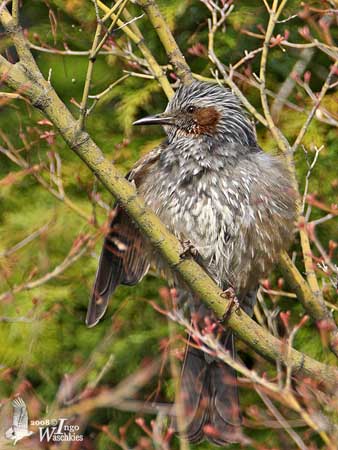
CALLS AND SONGS: SOUNDS BY XENO-CANTO
The Brown-eared Bulbul is gregarious and noisy. It produces an unattractive sound, a loud “shreep” or “weesp” heard all year round.
In Philippines, its voice appears harsher “pee-yuk”, or it utters descending and accelerating series “pee-yuk p-uk p-uk p-uk”
When in flocks, they can be very noisy, giving continuously loud vocalisations, fluty calls and chattering to communicate.
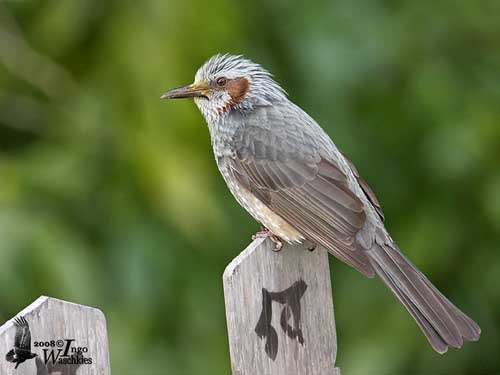
BEHAVIOUR IN THE WILD:
The Brown-eared Bulbul feeds primarily on plant materials. It takes wide variety of berries, holly, seeds, blossoms, citrus fruits such as mikan oranges (Citrus unshiu), and leafy vegetables, especially during winter in Japan.
It forages in gardens for nectar from flowers such as camellias and other species. The pollen often leaves its face dusted yellow. These birds are useful for pollination. It may occasionally take insects too.
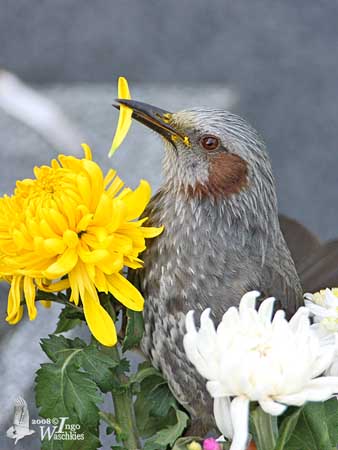
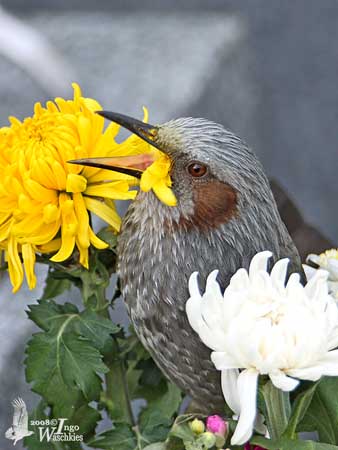
It feeds both on the ground and in bushes or fruiting trees, and takes berries by plucking while perched.
They often occur in groups, and sometimes, they can damage orchards and other crops. The Brown-eared Bulbul can be aggressive at bird-feeders during winter, and it is often the dominant species.
It often perches on fences and top of bushes from where it gives its loud calls while being restless.
During the breeding season, the Brown-eared Bulbul becomes territorial and can be aggressive. It may fight against other bulbuls, and it strongly defends the nest against all types of predators.
Courtship behaviour is poorly known for this species. However, the male postures in front of the female by performing bowing, drooping the wings, moving its head to enhance the chestnut patch. The crest is raised. The tail is fanned and raised in order to display the conspicuous undertail-coverts and their broad white edges.
Some sounds probably accompany these displays.
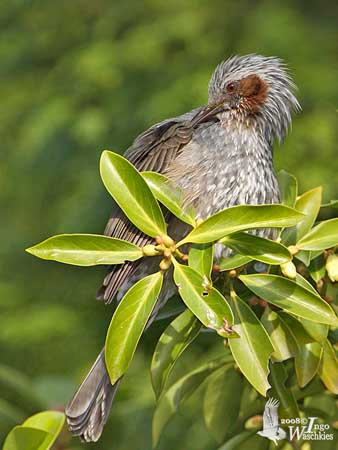
The Brown-eared Bulbul is mostly resident in its range. However, non-breeding birds from Hokkaido move southwards or perform altitudinal movements in late September. They reach the plains and the suburban areas where they often occur in large numbers during winter.
They move by day and often in large flocks.
The Brown-eared Bulbul has a strong undulating flight, often high, powerful and sustained.
REPRODUCTION OF THIS SPECIES:
The breeding season takes place in April/July-August.
The Brown-eared Bulbul builds a robust cup-shaped nest in low branch of tree, or in bush, vines and even man-made structures. The nest is placed between 1, 5 and 4, 5 metres above the ground. The nesting materials are highly variable and usually found in the vicinity of the nest-site.
Usually, the female does most of the work, but the male performs mate-guarding and accompanies its mate all the while.
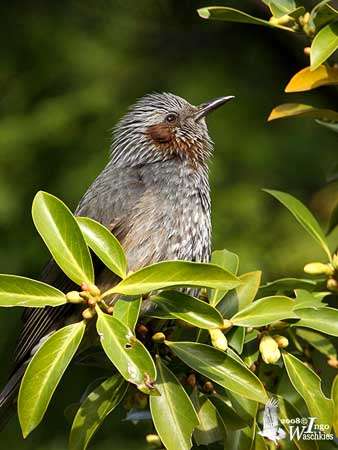
The female lays 3-5 eggs and incubates during 13-14 days. Unfortunately, the open cup-shaped nest makes it vulnerable to brood parasitism by cuckoos. However, if not parasitized, the chicks fledge 10-11 days after hatching.
The family group remains on its territory for two months.
This species usually produces several broods per season.
PROTECTION / THREATS / STATUS:
The Brown-eared Bulbul is abundant and widespread throughout Japan, especially on offshore islands. The species is fairly common in its range, except in Taiwan.
But it has recently expanded its range into urban areas in Japan. On the other hand, it is considered a pest due to its habit of damaging orchards and crops.
The Brown-eared Bulbul is not currently threatened.
